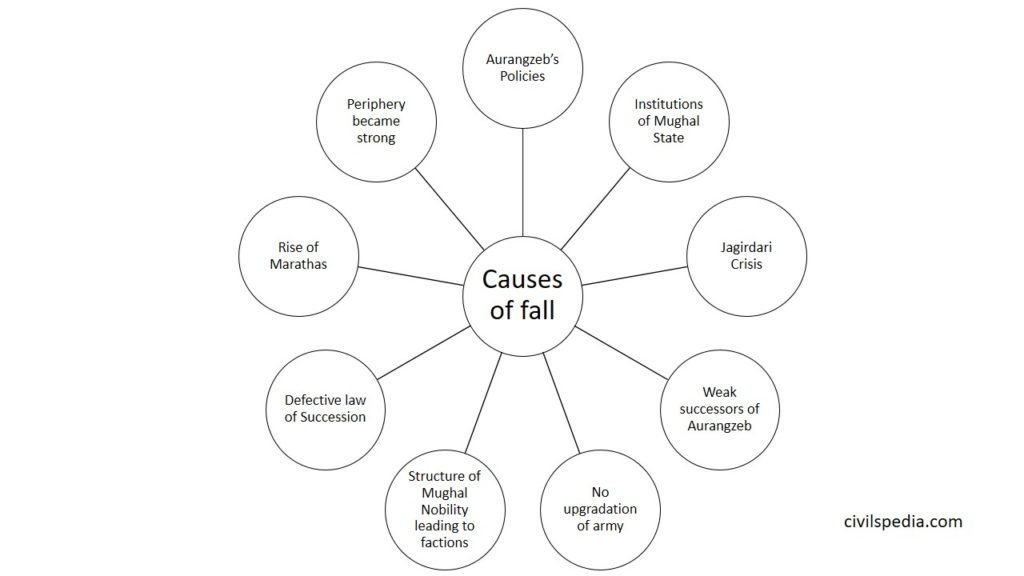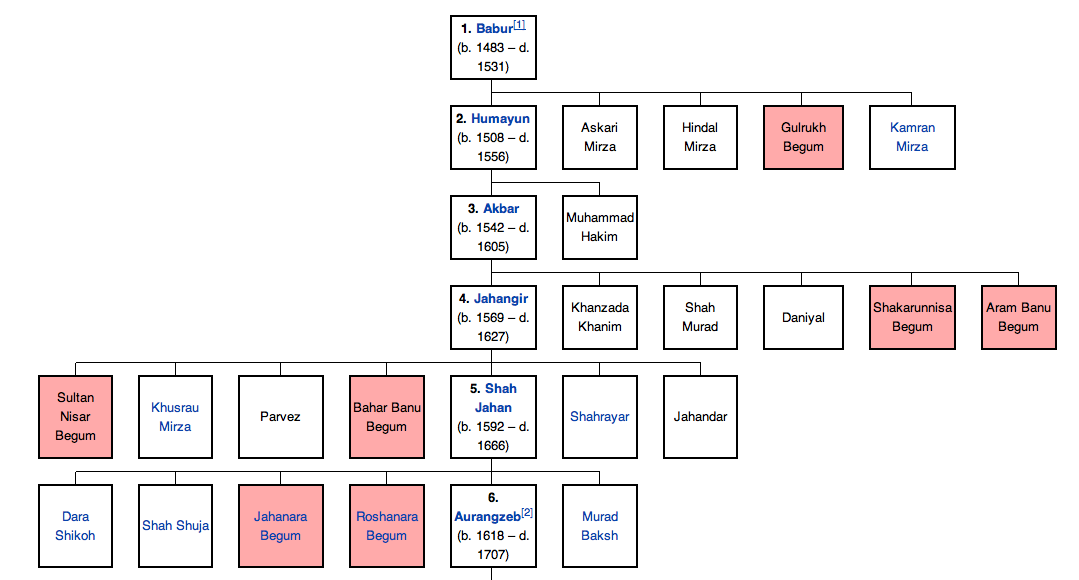Mughal Emperors Family Tree Royal family trees, Family tree, Mughal

History Of India The Mughal Emperors Administration and Hierarchies subratachak
The list of Mughal emperors who ruled India is given below: Aspirants can also go through India under the Mughal for detailed information on the Mughal rule in India. Also read, Akbar's Successors Humayun 1530 -1556 Important dynasties and kingdom of Ancient India Mughal Emperors - Sample Questions & Answers

History chart of mughal emperor Brainly.in
Flow Chart of Mughal Empire | PDF | Mughal Empire | Timurid Dynasty Flow Chart of Mughal Empire - Read online for free.

Pin on data
The weak Mughal emperor Nasir ud-Din Muhammad Shah can't prevent Nadir Shah of Afghanistan from sacking Delhi and massacring thousands, and claiming all territory west of the Indus; this is a mortal wound to the empire; Saadat Khan of Avadh negotiates a truce, but on humiliating terms: r.1739-56-- Safdar Jang in Avadh

Reasons of fall of Mughal Empire
The empire was founded by the Mongol leader Babur in 1526, when he defeated Ibrahim Lodi, the last of the Afghan Lodi Sultans at the First Battle of Panipat, where they used gunpowder for the first time in India. The Mughal Empire is known as a "gunpowder empire.". The word "Mughal" is the Indo-Aryan version of " Mongol .".

draw a flowchart of ancient mughal Kings and they time of ruling Brainly.in
Culture. Mughal culture was a blend of Persian and Indian elements. The empire produced rich literature, art, and music, including miniature paintings. The Mughals were patrons of the arts and promoted cultural diversity. The Mughal Empire practice Sunni Islam. Akbar the Great practiced religious tolerance, but not all leaders did the same.

Timeline Of Mughal Dynasty
The Mughal Empire stretched across most of northern and central India, and what is now Pakistan, from 1526 to 1857, when the British exiled the last Mughal emperor.Together, the Muslim Mughal rulers and their predominantly Hindu subjects created a golden age in Indian history, full of art, scientific achievement, and stunning architecture.

Spectrum Educational Charts Chart 297 Mughal Period
Emperors Jahāngīr (left), Akbar (centre), and Shah Jahān (seated at right) are depicted with their ministers and Prince Dārā Shikōh in a watercolour from India from the 1600s. Development of the Mughal Empire Mughal dynasty, Muslim dynasty of Turkic-Mongol origin that ruled most of northern India from the early 16th to the mid-18th century.

Find mughal empire map, highlights the empire during Babur, Akbar and Aurangzeb with cities and
The Mughal state was established by the Sultan Babur in the sixteenth century, with his legendary victory over the Lodhi Sultan in 1526. Babur used 20 cannons to defeat an army twice the size of his own. But he died two years later, so it wasn't really Babur's leadership that sustained his dynasty.

Mughal Empire Family Tree ganesh Medium
The Mughal Empire, descendants from the Mongol Empire of Turkestan in the 15th century, ruled the majority of India and Pakistan during the 16th and 17th centuries. Although this was an Islamic empire, the Mughals tolerated other religions even as they spread Muslim art, faith, and culture.

Leaders and Social Structure Mughal Empire
Last Updated on : 09/10/2013 Live Cricket Score Villages in India Family Tree and genealogy of Mughals. Find the flow chart of mughal emperors from Timur to Bahadur Shah Zafar.

family tree of mughal empire Ancient history facts, Indian history facts, Ancient history timeline
Babur (Persian: بابر, romanized: Bābur, lit. 'tiger/panther'; Persian pronunciation:; 14 February 1483 - 26 December 1530; born Zahīr ud-Dīn Muhammad) was the founder of the Mughal Empire in the Indian subcontinent.He was a descendant of Timur and Genghis Khan through his father and mother respectively. He was also given the posthumous name of Firdaws Makani ('Dwelling in Paradise').

Family Tree of Mughals Family tree, Indian history facts, Royal family trees
1556-1605 Mughal Empire The Mughal Empire was established in the northern part of the Indian subcontinent in the 1520s. By the early 1700s the Mughals had conquered most of the subcontinent, except the far south. Encyclopædia Britannica, Inc. Humāyūn's son Akbar consolidates the Mughal Empire.

The Mughal Empire Indian history facts, Ancient history facts, World history facts
Mughal emperors The Mughal emperors were the supreme monarchs of the Mughal Empire in the Indian subcontinent, mainly corresponding to the modern countries of India, Pakistan, Afghanistan and Bangladesh. They ruled parts of India from 1526, and by 1707, ruled most of the subcontinent.

Mughal Emperors Family Tree Royal family trees, Family tree, Mughal
THE SUR DYNASTY (1540-55) AND THE MUGHAL RESTORATION (1555-6)¯ Sher Shah S¯ ur (1540-5) founded an empire that included not only the territories of the¯ old Lodi empire, but also Bengal, Malwa, much of Rajasthan and Multan. During his five-year reign, he was continuously engaged in military operations and died as the result of a

Military of the Mughal Empire
SUMMARY OF THE MUGHAL EMPIRE; Flow Chart Of The Mughal Kings; videos of the rulers; PPT ON THE MUGHAL EMPERORS; QUESTION AIR; Submit your project; Flow Chart Of The Mughal Kings. RULERS.

Remix of "Mughal Empire Timeline"
Fig. 1 The Red Fort. Who were the Mughals? The Mughals were descendants of two great lineages of rulers. From their mother's side they were descendants of Genghis Khan (died 1227), ruler of the Mongol tribes, China and Central Asia.